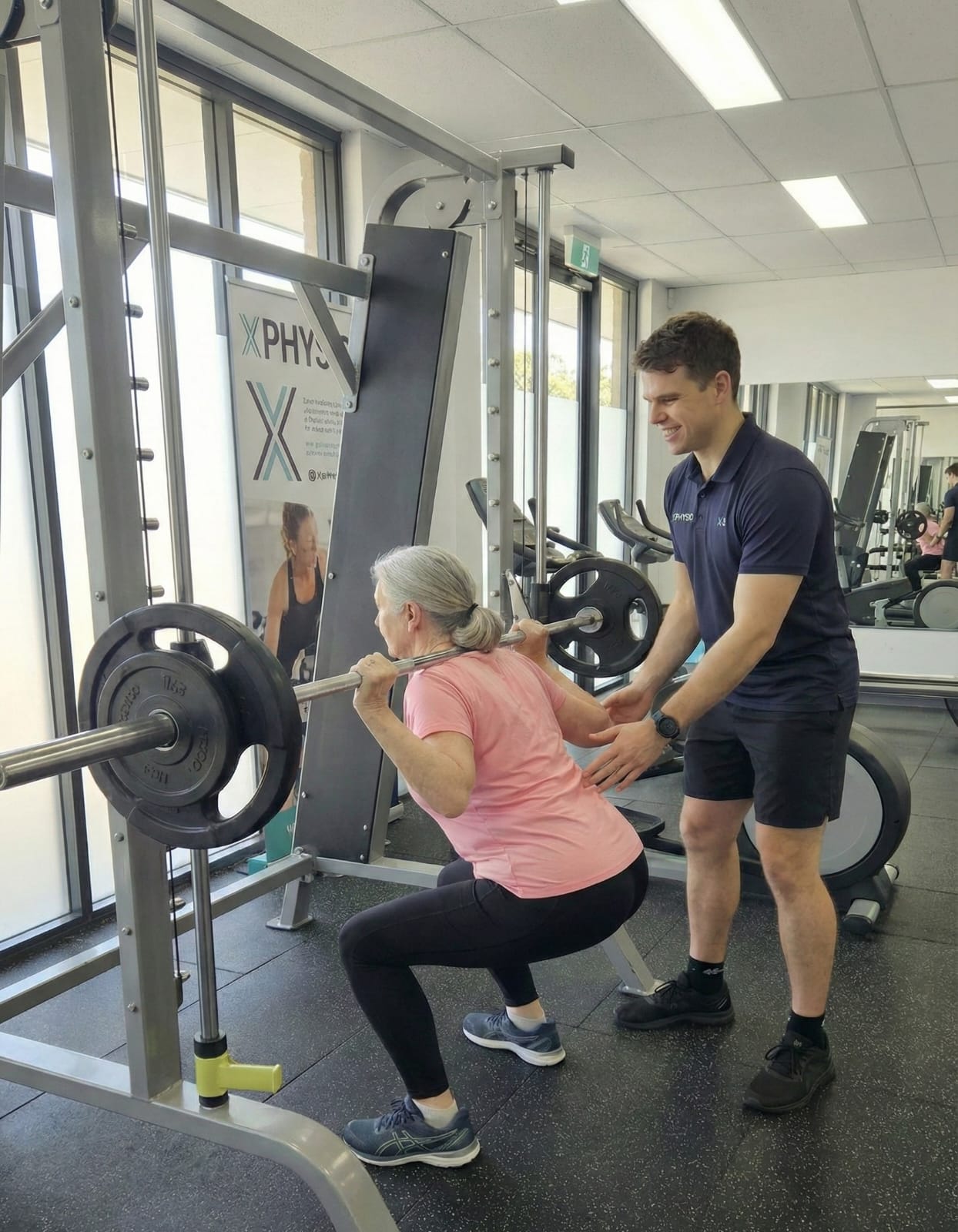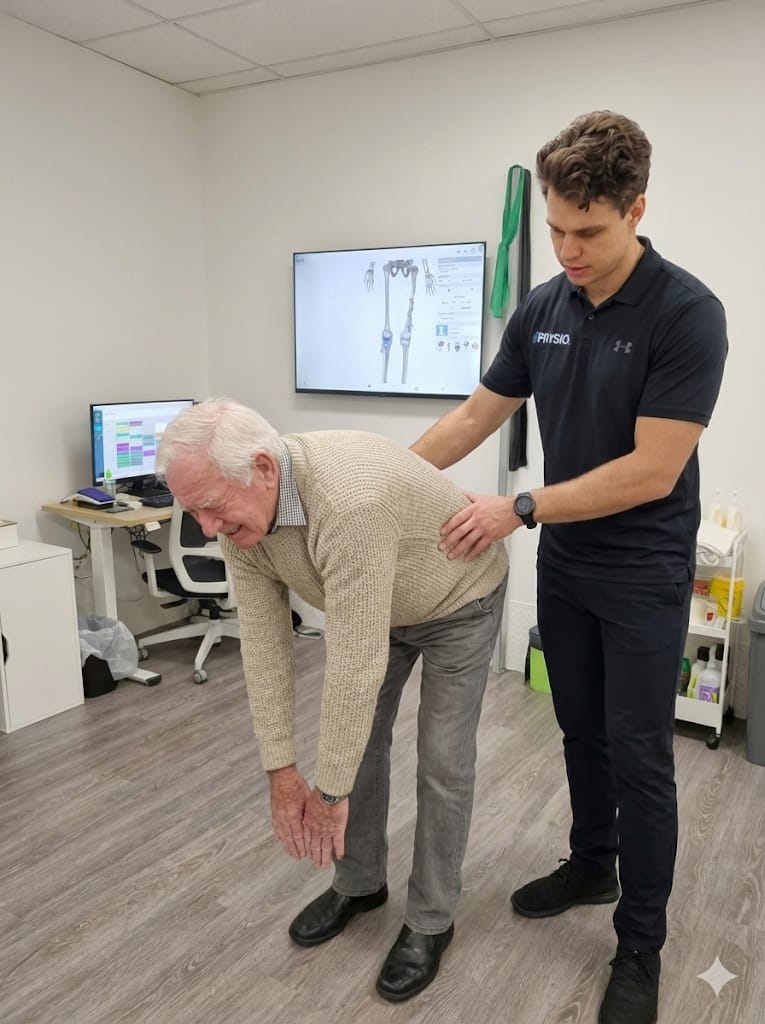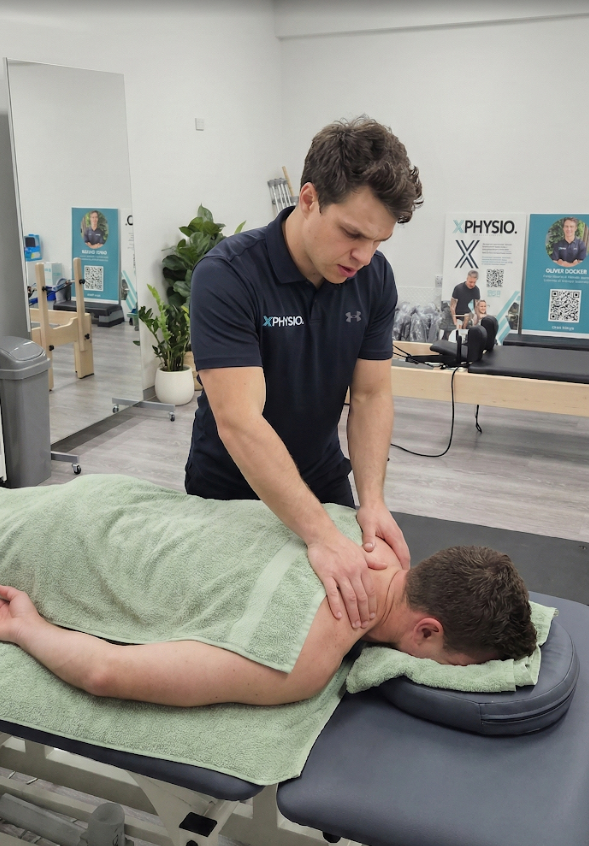
45) Power Through a Hamstring Strain: How Physio Gets You Back on Track
Hamstring strain slowing you down? You’re not alone. This common muscle injury can sideline runners, gym-goers and weekend warriors alike—but the good news is, with the right physiotherapy approach, recovery can be faster and more effective. Read on for expert tips, recovery timelines, and a real-life case of a hamstring rehab done right.
What is a Hamstring Strain?
A hamstring strain refers to an overstretch or tear in one or more of the three muscles—located at the back of your thigh. These muscles (biceps femoris, semitendinosus and semimembranosus) play a big role in walking, running, bending the knee and extending the hip.
Injuries usually occur during explosive or fast movements, such as sprinting, kicking, or lunging. That’s why they’re so common in sports like AFL, soccer, and athletics.

What Causes a Hamstring Strain?
There’s no single cause, but these factors often contribute:
- Lack of warm-up or poor flexibility
- Previous hamstring injury (huge risk factor!)
- Fatigue or overtraining
- Poor running technique or posture
- Muscle imbalances, especially weak glutes or quads
- Sudden change in intensity during sport
How Do You Know if It’s a Hamstring Strain?
Common symptoms include:
- Sudden sharp pain at the back of the thigh (it looks like they have been snipered)
- Feeling a “pop” during activity
- Swelling or bruising (especially in more severe cases)
- Weakness or difficulty walking, running, or bending the knee
- Tenderness when pressing on the muscle
If you’re limping or can’t walk without pain, it’s best to get assessed straight away.
Hamstring Strain Grading
Physios classify these injuries into three grades:
| Grade | Description | Symptoms |
|---|---|---|
| Grade 1 | Mild strain, small muscle fibre tears | Tightness, slight discomfort, minimal strength loss |
| Grade 2 | Moderate tear | Sharp pain, swelling, partial loss of strength |
| Grade 3 | Severe tear or complete rupture | Intense pain, bruising, major weakness or inability to walk |
There has been research to show that the amount of days spent limping after a hamstring strain is correlated to the amount of weeks of sport missed in the players chosen sport.
Why Physiotherapy is Crucial for Hamstring Rehab
Too many people make the mistake of resting too much or too little after a strain. Without proper rehab, you’re at high risk of reinjury—and the repeat episodes are often worse.
That’s where physiotherapy makes a massive difference. At our clinic, we tailor your rehab to your specific injury grade, activity level, and goals. Our approach includes:
✅ Hands-on treatment to reduce pain and swelling
✅ Individualised exercise programs to rebuild strength and flexibility
✅ Neuromuscular retraining to improve control and technique
✅ Education to prevent future strains
✅ Return-to-sport guidance based on real benchmarks, not guesswork

Real Case Study: Jack’s Return to Soccer
Jack, a 28-year-old semi-pro soccer player from Narraweena, came to our clinic after tearing his hamstring during a sprint drill. He felt a sharp pull in his right thigh and couldn’t finish training. An ultrasound confirmed a Grade 2 hamstring strain.
Week 1-2: We started with soft tissue release, gentle range-of-motion exercises and isometrics to keep the muscle engaged without overstressing it.
Week 3-4: Jack progressed to dynamic strengthening—single-leg bridges, Nordic curls, and resistance band work. Dry needling also helped settle deep muscle tightness.
Week 5-6: We ramped up running drills, focusing on form, acceleration mechanics and hamstring endurance. Jack also trained glutes and core to address muscle imbalances.
Week 7: With sprint testing and strength measures back to baseline, Jack returned to modified team training.
Week 8: Fully cleared for competition. No pain. No fear. Just goals.
Today, Jack’s back playing confidently and still checks in for maintenance treatment.
Key Phases of Recovery
Let’s break it down. While recovery time can vary depending on severity and individual healing, here’s a general guideline:
1. Acute Phase (0–7 days)
- Protect the area – no stretching!
- Ice, gentle compression, and elevation
- Start isometric holds if pain allows
- Avoid aggravating movements
2. Subacute Phase (1–3 weeks)
- Gentle mobility and pain-free range of motion
- Begin light strengthening
- Address compensations or movement faults
3. Strength & Conditioning Phase (3–6 weeks)
- Functional hamstring exercises
- Glute and core activation
- Progressive resistance training
- Balance and proprioception
4. Return-to-Sport Phase (6+ weeks)
- Sprint mechanics and agility work
- Power-based movements (plyometrics, bounding)
- Confidence-building under sport-specific conditions

Must-Do Physio Exercises for Hamstring Strains
These are a few of our go-to exercises (only perform under guidance of your physio):
- Hamstring bridges (double and single-leg)
- Nordic hamstring curls
- Deadlifts with light weights
- Step-throughs or resisted running drills
- Lunges and high knees for dynamic mobility
Can You Prevent Hamstring Strains?
Yes! Prevention is way better than cure—especially with something as stubborn as a hamstring strain. Here’s how:
- Warm up thoroughly before activity
- Strengthen your hamstrings, especially eccentrically (lengthening under load)
- Stretch regularly, especially after training
- Fix technique issues in running or kicking
- Don’t neglect recovery—sleep, nutrition and mobility matter
- Balance your program with core and glute work

Should You Get a Scan?
Physios can usually assess and diagnose a hamstring strain clinically, but scans like ultrasound or MRI can help:
- Confirm severity (especially in Grade 2 or 3 cases)
- Rule out complete tendon avulsions or other injuries
- Guide return-to-play timelines for competitive athletes
Your physio can refer you for imaging if needed—no GP referral necessary.
When to See a Physio
Come in if:
- You feel a sharp pain or pull in the back of your thigh
- You’re limping, or avoiding weight on one leg
- You’ve had recurrent hamstring issues
- You’re unsure when it’s safe to return to activity
- You want a sport-specific rehab plan
The earlier we see you, the better the outcome—early treatment prevents scar tissue and speeds recovery.
Don’t Ignore the Warning Signs
If you’ve had a minor hamstring niggle for weeks that never fully settles, don’t shrug it off. Many patients come in after the second or third strain, and by then the tissue takes longer to heal and your movement patterns are harder to retrain.
Some players take a proactive approach by booking in for an athlete screening session with one of our physiotherapists to determine if they have any risk factors for a hamstring strain and treat them to reduce the chance of an injury. Read HERE for our blog on this topic.
Take Home Message
A hamstring strain doesn’t have to derail your fitness goals. With early intervention, expert guidance and the right rehab, you can bounce back stronger than before. Whether you’re a weekend jogger or a competitive athlete, physiotherapy is your best shot at a smooth, confident recovery.
Need help with a hamstring injury?
Give us a call today on 9806 3077, or book online—just CLICK HERE and let’s get you moving again.
References & Useful Links:
- Sports Medicine Australia – Hamstring Strain Fact Sheet
- Physiopedia – Hamstring Injury Rehabilitation
Let us help you power through the pain and return stronger than ever.



